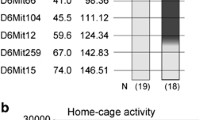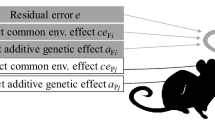Abstract
The locomotor activity of male mice (Mus musculus) of 13 CXB (BALB/cBy × C57BL/6J) recombinant inbred (RI) strains and their progenitor strains was monitored for 4 to 6 weeks by infrared photoelectric beams under constant dark. The circadian period (τ) of locomotor activity was calculated and used in quantitative trait locus (QTL) analysis of strains' means. Results were compared with potential QTL found in a previous study of the BXD RI series. The mean τ of 13 CXB RI mouse strains (three to six animals per strain) in constant dark had a unimodal distribution suggesting polygenic inheritance. A number of potential QTL were found for this trait. There were two associations atp<.001,H23 on chromosome 3 andPmv16 on chromosome 16. A region of chromosome 1 was associated with τ in both CXB and BXD RI series. There was also a conjunction with a locus determined from QTL analysis of the previously reported τ of wheel running activity in seven CXB RI strains (Schwartz and Zimmerman, 1990).
Similar content being viewed by others
References
Beau, J. (1986). Components comparison of activity rhythm in three inbred mice strains. In Medoni, J. and Vaysse, G. (eds.),Genetic Approaches to Behavior, Privat IEC, Toulouse, pp. 19–27.
Beau, J. (1991). Activity rhythms in inbred mice. I. Genetic analysis with recombinant inbred strains.Behav. Genet. 21:117–129.
Belknap, J. K. (1992). Empirical estimates of Bonferroni corrections for use in chromosome mapping studies with the BXD recombinant inbred strains.Behav. Genet. 22:677–684.
Belknap, J. K., Metten, P., Helms, M. L., O'Toole, L. A., Angeli-Gade, S., Crabbe, J. C., and Phillips, T. J. (1993). Quantitative trait loci (QTL) applications to substances of abuse: Physical dependence studies with nitrous oxide and ethanol in BXD mice.Behav. Genet. 23:213–222.
Berrettini, W. H., Ferraro, T. N., and Alexander, R. C. (1994). Quantitative trait loci mapping of three loci controlling morphine preference using inbred mouse strains.Nature Genet. 7:54–58.
Crabbe, J. C., Kosobud, A., Young, E. R., and Janowsky, J. S. (1983). Polygenic and single gene determination of responses to ethanol in BXD/Ty recombinant inbred mouse strains.Neurobehav. Toxicol. Teratol. 5:181–187.
Crabbe, J. C., Belknap, J. K., and Buck, K. J. (1994). Genetic animal models of alcohol and drug abuse.Science 264: 1715–1723.
Dietrich, W., Katz, H., Lincoln, S. E., Shin, H. S., Friedman, J., Dracopoli, N. C., and Lander, E. S. (1992). A genetic map of the mouse suitable for typing intraspecific crosses.Genetics 131:423–447.
Ebihara, S., and Tsuji, K. (1976). Strain differences in the mouse's wheel-running behavior.Jpn. J. Psychol. Res. 18:20–29.
Ebihara, S., Tsuji, K., and Kondo, K. (1978). Strain differences in the mouse's free-running circadian rhythm in continuous darkness.Physiol. Behav. 20:795–799.
Edgar, D. M., Martin, C. E., and Dement, W. C. (1991). Activity feedback to the mammalian circadian pacemaker: Influence on observed measures of rhythm period length.J. Biol. Rhythms 6:185–199.
Flint, J., Corley, R., DeFries, J. C., Fulker, D. W., Gray, J. A., Miller, S., and Collins, A. C. (1995). A simple genetic basis for a complex psychological trait in laboratory mice.Science 269:1432–1435.
Gora-Maslak, G., McClearn, G., Crabbe, J. C., Phillips, T., Belknap, J., and Plomin, R. (1991). Use of recombinant inbred strains to identify quantitative trait loci in psychopharmacology.Psychopharmacology 104:413–424.
Hofstetter, J. R., Mayeda, A. R., Possidente, B., and Numberger, J. I., Jr. (1995). Quantitative trait loci (QTL) for circadian rhythms of locomotor activity in mice.Behav. Genet. 52:545–556.
Jackson, F. R. (1993). Circadian rhythm mutants ofDrosopholia. In Young, M. W. (ed.),Molecular Genetics of Biological Rhythms, Marcel Dekker, New York, pp. 91–121.
Johnson, T. E., DeFries, J. C., and Markel, P. D. (1992). Mapping quantitative trait loci for behavioral traits in the mouse.Behav. Genet. 22:635–653.
Lander, E., and Botstein, D. (1989). Mapping mendelian factors underlying quantitative traits using RFLP linkage maps.Genetics 121:185–199.
Lander, E. S., and Schork, N. J. (1994). Genetic dissection of complex traits.Science 265:2037–2048.
Manly, K. F. (1993). A Macintosh program for storage and analysis of experimental genetic mapping data.Mamm. Genome 4:303–313.
McClearn, G. E., Plomin, R., and Gora-Maslak, G. (1991). The gene chase in behavioral science.Psychol. Sci. 2:222–229.
Mrosovsky, N. (1989). Nonphotic enhancement of adjustment to new light-dark cycles: Masking interpretation discounted.J. Biol. Rhythms 4:365–370.
Neumann, P. E., and Collins, R. L. (1991). Genetic dissection of susceptibility to audiogenic seizures in inbred mice.Proc. Natl. Acad. Sci. USA 88:5408–5412.
Neumann, P. E., and Seyfried, T. N. (1990). Mapping of two genes that influence susceptibility to audiogenic seizures in crosses of C57BL/6J and DBA/2J mice.Behav. Genet. 20:307–323.
Nolan, P. M., Sollars, P. J., Bohne, B. A., Ewens, W. J., Pickard, G. E., and Bucan, M. (1995). Heterozygosity mapping of partially congenic lines: Mapping of a semidominant neurological mutation,Wheels (Whl), on mouse chromosome 4.Genetics 140:245–254.
Oliverio, A., and Malorni, W. (1979). Wheel-running and sleep in two strains of mice: Plasticity and rigidity in the expression of circadian rhythmicity.Brain Res. 163:121–133.
Peleg, L., Nesbitt, M. N., and Ashkenazi, I. E. (1989). Strain dependent response of circadian rhythms during exposure to constant illumination.Life Sci. 44:893–900.
Phillips, T. J., Belknap, J. K., and Crabbe, J. C. (1991). Use of recombinant inbred strains to asses vulnerability to drug abuse at the genetic level.J. Addict. Dis. 10:73–87.
Pickard, G. E., Sollars, P. J., and Rinchik, E. M. (1994). Mutagenesis screen identifies a mouse (187) with altered circadian rhythms.Society for Research on Biological Rhythms: Abstracts, 58.
Possidente, B., and Hegmann, J. P. (1982). Gene differences modify Aschoff's rule in mice.Physiol. Behav. 28:199–200.
Possidente, B., and Stephan, F. K. (1988). Circadian period in mice: Analysis of genetic and maternal contributions to inbred strain differences.Behav. Genet. 18:109–117.
Ralph, M. R., and Menaker, M. (1988). A mutation of the circadian system in golden hamsters.Science 241:1225–1227.
Reebs, S. G., and Mrosovsky, N. (1989). Effects of induced wheel running on the circadian activity rhythms of syrian hamsters: Entrainment and phase response curve.J. Biol. Rhythms 4:39–48.
Reebs, S., Lavery, R., and Mrosovsky, N. (1989). Running activity mediates the phase-advancing effects of dark pulses on hamster circadian rhythms.J. Comp. Physiol. [A] 165:811–818.
Rosbash, M., and Hall, J. C. (1989). The molecular biology of circadian rhythms.Neuron 3:387–398.
Schwartz, W. J., and Zimmerman, P. (1990). Circadian time-keeping in BALB/c and C57BL/6 inbred mouse strains.J. Neurosci. 10:3685–3694.
Seyfried, T. N., Yu, R., and Glaser, G. H. (1980). Genetic analysis of audiogenic seizure susceptibility in C57/BL/6J × DBA/2J recombinant inbred strains of mice.Genetics 994:701–718.
Takahashi, J. S., Pinto, L. H., and Vitaterna, M. H. (1994). Forward and reverse genetic approaches to behavior in the mouse.Science 264:1724–1733.
Tarricone, B. J., Hingtgen, J. N., Belknap, J. K., Mitchell, S. R., and Nurnberger, J. I., Jr. (1995). Quantitative trait loci associated with the behavioral response of BXD recombinant inbred mice to restraint stress: A preliminary communication.Behav. Genet. 25:489–495.
Taylor, B. A. (1990). Recombinant inbred strains. In Lyon, M. F., and Searle, A. G. (eds.),Genetic Variants and Strains of the Laboratory Mouse, Oxford University Press, Oxford, pp. 773–796.
Vitaterna, M. H., King, D. P., and Chang, A.-M. (1994). Mutagenesis and mapping of a mouse geneClock essential for circadian behavior.Science 264:719–725.
Author information
Authors and Affiliations
Corresponding author
Rights and permissions
About this article
Cite this article
Mayeda, A.R., Hofstetter, J.R., Belknap, J.K. et al. Hypothetical quantitative trait loci (QTL) for circadian period of locomotor activity in CXB recombinant inbred strains of mice. Behav Genet 26, 505–511 (1996). https://doi.org/10.1007/BF02359755
Received:
Accepted:
Issue Date:
DOI: https://doi.org/10.1007/BF02359755




